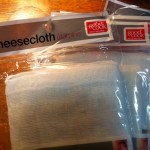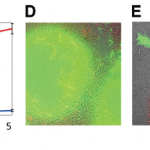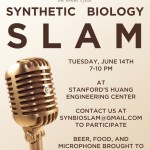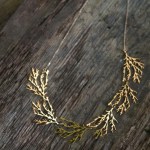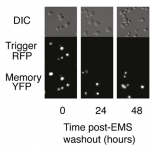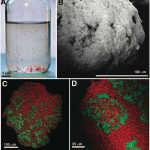
Oscillator is moving to the brand new Scientific American network! I'm excited for this new opportunity and sad to be leaving my old home here. I want to give many special thanks to SEED people past and present for their help and support, in particular Nikki, Erin, Greg, Evan, and Wes. And of course I have to thank all of you who read and commented and shared and supported me here, I hope you change your RSS feeds and bookmarks and come visit me at my new spot!
I'm making my way up to SB 5.0 for what promises to be a great conference. If you're going too, come say hi and smell some cheeses during the poster session!
I got a long email from one of the authors of the skull measuring study and I want to make some clarifications to my previous post. It seems that I was not as clear and thorough as I could have been in my argument.
First, my sincere apologies to all physical anthropologists and other researchers who routinely measure skulls that I may have offended with my off-hand comments. I did not intend to cast doubt on a whole field, and I am aware that there are lots of reasons to look at skulls besides comparing cranial capacity of different races, many of them very valuable to medicine and…
It's not every day that you read about measuring skulls in the contemporary scientific literature. It's kind of a quaintly old-timey, quaintly racist kind of thing to do. But here we are, with a brand new paper about skull measuring in PLoS Biology. Already quite a few blog-words have been written in support of this new paper, which disproves Stephen Jay Gould's assertion in The Mismeasure of Man that George Morton's 1839 skull measurements were fudged intentionally or unintentionally by his racist bias.
I haven't read a lot of Gould, and I'm pretty convinced by the numbers in the paper…
Last month I wrote about my friend Devin Burrill's paper about synthetic memory in yeast cells. There were a lot of really interesting questions left in the comments, and I asked Devin if she would write a guest post to answer them. She agreed and here it is, answers to your questions straight from the author!
Hello Readers!
My name is Devin, and I am so incredibly grateful to Christina for allowing me to write an entry on her awesome blog. Christina and I are friends and work together in the lab of Pamela Silver at Harvard Medical School. I am writing in response to a number of excellent…
It's been an exciting week for me. On Monday I successfully defended my thesis! Now that I have established my scientific credibility to you all, here is a picture of me at my defense party wearing my "Trust me I'm a Dr" Dr. Pepper t-shirt and hitting my SpongeBob SquarePants piñata.
And on Tuesday I went to two really interesting events/talks/discussions about science and scientists. First up was Debbie Chachra's awesome seminar "Unpacking Gender: Men and Women in Science, Technology, and More," sponsored by the Harvard Graduate Women in Science and Engineering. She described her seminar…
Two videos that Patrick Boyle and I made were selected for the Bio:Fiction Film Festival! One of the prizes is an online audience award, and you can watch and rate all of the films! It's such an honor to be part of this festival and to be showing our work next to that of so many amazing artists, scientists, and filmmakers, and we would be super thrilled if you voted for us!
Here are our videos! First, the world premiere of Compound 74, a fictional documentary about a possible future of synthetic drug design through synthetic biology:
And second, the commercial we made for Ginkgo BioWorks--…
Beautiful video imagining the future of augmented, prosthetic sight, by Superflux for the Human+ exhibition:
Song of the Machine from Superflux on Vimeo.
You can read more about the science behind retinal prosthetics in a great article in the Guardian by one of the project collaborators, Dr. Patrick Degenaar.
Symbiosis is everywhere. From the Greek for "living with," symbiosis is simply a close association between two different species in nature. These relationships can be mutualistic, parasitic, or somewhere in between. Bacterial symbionts live inside bodies, like the bacteria that help us and other animals digest our food, and they live inside cells, like the bacteria that live in plant roots and provide their hosts with nitrogen. They can be metabolic, hygienic, or photosynthetic; ectosymbiotic, on the host surface, or endosymbiotic, inside the host's cells. Back in the 1860's biologists…
Before you get your tickets for SB 5.0 make sure that you'll be in town for the world's first Synthetic Biology Slam!
Valerie Weiss is not just a film director with a fun new movie coming out, she's also a scientist. After getting her PhD from Harvard (from the same lab as me!) she created PhD Productions, and her newest film is a quirky romantic comedy look at the life of a neurotic graduate student. "Losing Control" "blurs the lines between science and love," as our grad student hero tries to decide whether her boyfriend in "the one" through a series of controlled experiments. Here's the trailer:
There's going to be a screening of the movie this Friday at Harvard, free with Harvard student ID. Maybe I'll…
Perhaps you have noticed that I haven't been blogging very much lately. Probably not, which is why I don't ever do these "sorry for not posting" posts, but I'm making an exception this time because it is a very special occasion. So, apologies for my recent lack of posts, but I got married last weekend! Of course, my wedding was not without biologically inspired design appropriate for mention on this blog. On my special day I wore Nervous System's algae inspired Filament Necklace.
Nervous System is a small and awesome company that combines background in biology, architecture, math, and…
Cells permanently change their behavior in response to temporary changes to the environment, a kind of biological memory that controls processes as important and complex as how stem cells differentiate into specific tissues or how the immune system "remembers" dangerous pathogens. At its simplest, cellular memory is achieved with a positive feedback loop--once activated by some external signal, the feedback loop will continually activate itself, even as the cell divides and the signal is taken away. In synthetic biology we can recreate such simple feedback loops, genetic circuits built of…
I recently learned that one of my advisors and mentors is not only a great scientist, but also a poet. This poem was written a few years ago for his biotech company's clean-up day poetry contest and won him a $5 gift certificate to Dunkin Donuts. I think it's actually quite good and deserves more attention than that so I'm reproducing it here, with permission from the author.
Squeal by Jeff Way (with apologies to Allen Ginsberg):
I saw the best minds of my generation destroyed by cleanliness, crazed drooling wrapped in lab coats, dragging themselves through the late-night fluorescent…
Changing our energy infrastructure from one that contributes to climate change to one that is renewable and sustainable poses enormous challenges technically, politically, socially, and economically. There isn't going to be a single solution, but a combination of technological changes, policy changes, efficiency gains, and adaptations to local environments will likely go a long way to making our current system better.
But there is a big difference between better and good. In Cradle to Cradle: Remaking the Way We Make Things, architect Bill McDonough and environmental chemist Michael…
One organism's trash is another organism's treasure. Our cellular wastes, carbon dioxide and water, nourish plants, which with added energy from sunlight produce the oxygen and sugars that we need to survive. At microscopic scales, these cycles of waste and food can get much more complicated, with many species of microbes working together to survive in harsh environments with limited nutrients.
When organisms (like us) digest sugars made of carbon (C), hydrogen (H), and oxygen (O), they split them up into carbon dioxide (CO2), hydrogen ions (H+) and high-energy electrons (e-) that were…
I had a great conversation with Maggie Koerth-Baker from BoingBoing for bloggingheads.tv Science Saturday. We talked about all sorts of sciency stuff, including her upcoming book on the challenges of renewable energy, synthetic biology, the similarities between cheese and the human body, women in science/blogging, and octopus brains. I had a lot of fun chatting with Maggie and I learned a lot, and I hope you will too!
Synthetic biologists work on designing living cells, but engineered bacteria don't usually come up when you think of "designer" things. This year however, a synthetic biology design is up for a Brit Insurance Design of the Year award, up against the Lanvin Spring collection, Angry Birds, and Rock Band 3! Designers Daisy Ginsberg and James King worked in collaboration with the 2009 Cambridge iGEM team (including awesome blogger Lab Rat) to imagine ways that people could use bacteria engineered to produce pigments in the future. Check out their video about the science and design of E. chromi:
The Harvard Microbial Sciences Initiative Graduate Consortium hosted a fun workshop during the January term where students learned about microscopy by taking some amazing pictures of food microbes. The images taken with the scanning electron microscope of sauerkraut, kombucha, and some stinky cheeses show beautiful and complex landscapes made by and of microbes.
Sauerkraut is fermented by cute rod-shaped lactic acid bacteria:
Kombucha, a tea fermented by a combination of yeasts and bacteria, looks incredible under the microscope, where you can see the dense mesh of cellulose fibers that the…
Scientists aren't known for their fashion sense, but they do have their own unique charm, as you can see in this episode of In The Lab, with Bill Cunningham.
